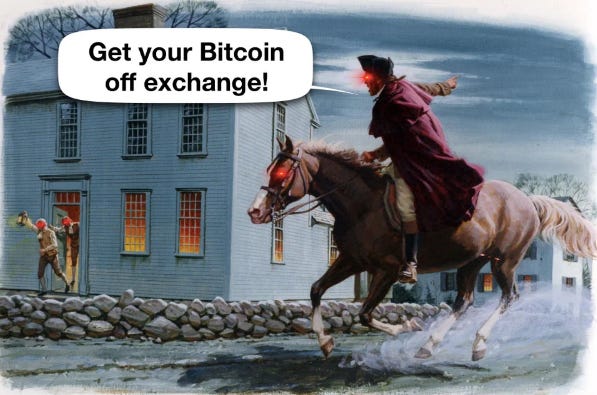Hey friends, welcome back to Think Bitcoin™ for issue #45. Special welcome to the new subscribers. I’m glad you’re here. As always, if you have any questions or comments, feel free to reach out. You can also find me on Twitter (@TheWhyOfFI) and connect with me on LinkedIn.
In this issue:
Long Reads: The Future is Orange - Reflections on the Pacific Bitcoin Conference
Content Round-Up: 2 videos, 1 article, 1 podcast, 1 very cool website
As always, if you find this newsletter interesting or useful, please share it with others who might find it interesting or useful, too!
This issue is sponsored by Orange Pill App. Connecting with other Bitcoiners is a great experience. Many of my own most interesting conversations each day occur with fellow Bitcoiners. Whether in real life or online, you can skip formalities and get right to discussing the transformative, wide-ranging effects of Bitcoin’s growth, knowing you share a hope for a more promising future. Thanks to Orange Pill App you are now able to meet Bitcoiners near you without the need to go to a meet-up or a conference. Sign up now!
Long Reads
The Future is Orange: Reflections on the Pacific Bitcoin Conference
Amidst the breathtakingly swift and brutal collapse of FTX, the ripples of market carnage it unleashed, and the extensive fraud it revealed, Bitcoiners descended upon Santa Monica, California, on November 10 for a two-day conference all about Bitcoin, the largest conference of its kind in the U.S.
The uninitiated would likely have expected the mood to be dour and defeated. Case in point, my taxi driver from the airport, after asking what brought me to California, actually asked me, “isn’t all that cryptocurrency stuff crashing right now?” He was visibly (and vocally) perturbed that I could remain optimistic about Bitcoin and travel across the country to attend a conference devoted to its growth.
But nowhere was the distinction between Bitcoin and the rest of crypto clearer, more pronounced, and more profoundly articulated than at this conference.
Some things I took away:
First, the beautiful collectivity of the Bitcoin space. Everyone in Bitcoin is bringing their own unique talents, skills, and gifts to bear upon the shared mission of advancing Bitcoin adoption and education. It’s hard for me to conjure an analogous movement with analogous participant dynamics.
Particularly spirited political campaigns perhaps share some similarities. But political campaigns unite narrower bands of people and are very localized. In contrast, there were many folks at Pacific Bitcoin who almost certainly disagree with each other on a multitude of other issues (in some cases, all other issues) but agree on the societal goodness (and the societal importance) of Bitcoin.
One related thought I had was that Bitcoin is the kind of big-tent movement capable of bringing ideologically disparate (and even ideologically opposed) people together to work in concert on a common mission that climate activists have (unsuccessfully, I think) tried to create around climate change.
It’s worth thinking about why Bitcoin is able to bring together ideologically different people more effectively than campaigns for climate change are. There are a multitude of reasons, I think. Too many to dive into here, surely. But for people who scoff at Bitcoin and consider it worthless, the reality that it does in fact unite people from such different political backgrounds is pretty clear evidence of its power and potential, particularly in a world where seemingly nothing else is capable of doing that.
My second takeaway was more of a renewed conviction and sharper focus on the difference between Bitcoin and the wider crypto space. If you’ve read my previous work, you know I’ve argued this difference from a few different perspectives, mostly focused on our interior lives and the arts (see issues #39, #42, and #43).
But the dizzying speed of FTX’s implosion, and the precipitous fall from grace of its CEO, Sam Bankman-Fried should reaffirm for everyone the need for trustless solutions, the importance of self-custodying your Bitcoin (more on this later), and the dangers of centralized intermediaries as devastating single points of failure.
Fiat incentives create and reward con-men, charlatans, and frauds. Get yourself close to the money printer by any means necessary, accrue as much trust to yourself as you can and, well, you’re probably going to do pretty well. Because that’s how the system works and that’s what it incentivizes.
Any enterprising person looking to leapfrog into wealth casts his/her aim on a seat next to the money printer, gazes longingly at rent-collecting, and daydreams about seigniorage. This as opposed to aspirations of productivity, of solving society’s most intractable problems, and generally adding value to the market. You can see how, structurally, this is a toxic set of incentives.
This is where Bitcoin and crypto differ so thoroughly and so compellingly. Crypto, though it presents seductively on the surface as as a system outside of fiat, traffics in its (fiat’s) same set of incentives Bitcoin, on the other hand, does not.
Bitcoin bends human action to a new, decidedly non-fiat set of incentives.
This monumentally important difference between Bitcoin and crypto is a difference that’s challenging to articulate to skeptics or no-coiners in short, pithy one-liners. It takes a conversation. Sometimes many conversations. Or, in the much more painful alternative, it takes an experience like losing your money on something like FTX or on the FTT token, or Terra/Luna to internalize it.
Crypto is much more like fiat than Bitcoin, which is like neither.
Until this difference is known, widely accepted, and generally acknowledged as obviously true, there will be more pain.

So we have lots to do. But, as the mood and conviction of Pacific Bitcoin speakers and attendees emphatically underscored, there are more and more of us stepping into the proverbial breach to do this work. And out of each FTX-level collapse, more of us are born.
The future is orange, friends.
Public Service Announcement: Self-Custody Your Bitcoin!
I cannot stress this enough. It’s the most salient, most urgent lesson to be learned by retail investors from the FTX debacle. Self-custody means take your bitcoin off centralized exchanges like Coinbase, Kraken, Gemini, Binance, etc. The whole purpose of Bitcoin is to hold your own private keys. When you keep your coins on an exchange, they (the exchange) hold your private keys - not you.
This means you have counterparty risk with your Bitcoin. If a centralized exchange (like, say, FTX) has a bank run, collapses, etc. you no longer have your Bitcoin.
Recall Satoshi’s words:
“The root problem with conventional currency is all the trust that's required to make it work. The central bank must be trusted not to debase the currency, but the history of fiat currencies is full of breaches of that trust. Banks must be trusted to hold our money and transfer it electronically, but they lend it out in waves of credit bubbles with barely a fraction in reserve. We have to trust them with our privacy, trust them not to let identity thieves drain our accounts. Their massive overhead costs make micropayments impossible.” (emphasis added)
Now, I know self-custodying your Bitcoin an be intimidating and feel overwhelming. But it is imperative that you take the time to learn how to do it.
Useful resources:
BTC Sessions has a tutorial on how to use basically every kind of wallet. You can find all those videos on his youtube channel.
Also: bitcoiner.guide
Content Round-Up
1. Days 1 and 2 on the Hard Money Stage at the Pacific Bitcoin Conference. If you weren’t able to attend, you can watch all of the speakers in the videos below.
2. “Hard on Bitcoin, Soft on Crypto Crime: A Case Study of the New York Times,” an article by Bradley Rettler about the stark difference between the way the New York Times is writing about the FTX fraud and the way it has historically reported on Bitcoin, “the one cryptocurrency that has no CEO, no corporation, no governing board, and no opportunity for this kind of fraud.”
3. “Michael Saylor on Bitcoin and Crypto in the Wake of FTX Collapse,” an episode of the Coin Stories podcast. This conversation is in the same vein as Saylor’s keynote talk on Day 2 of Pacific Bitcoin. He articulates the distinction between Bitcoin and crypto more cogently than anyone.
4. Timechain Calendar. This is a very cool, readable, not-overwhelming, and updated-in-real-time snapshot of the Bitcoin network.
As always, thanks for reading! If you enjoyed it or found it useful, share this newsletter widely and freely!
“Civilization is in a race between education and catastrophe. Let us learn the truth and spread it as far and wide as our circumstances allow. For the truth is the greatest weapon we have.” -H.G. Wells
See you in two weeks,
Logan
SPONSORSHIP INQUIRIES: If you’re a Bitcoin company (or you work for a Bitcoin company) and you’re interested in supporting the newsletter, please reach out via Twitter DMs (@TheWhyOfFI) or email (askthewhyoffi@gmail.com).
SUPPORT
Send bitcoin to my Strike
SOCIAL
DISCLAIMER: I am not investment advisor and this is not investment advice. This is not, nor is it intended to be, a recommendation to buy or sell any security or digital asset. Nothing in this newsletter should be interpreted as a solicitation, a recommendation, or advice to buy or sell any security or digital asset. Nothing in this newsletter should be considered legal advice of any kind. This newsletter exists for educational and informational purposes only. Do your own research before making any investment decisions.
© Copyright Logan Bolinger, Think Bitcoin LLC







Great post Logan! I love this, "Bitcoin bends human action to a new, decidedly non-fiat set of incentives."